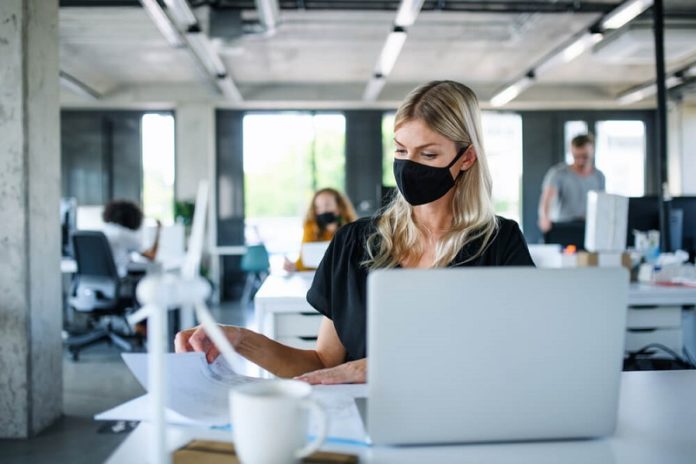A year after storefronts temporarily shuttered in response to the COVID-19 pandemic, businesses are eager to return to normal. Many have already resumed limited indoor activities, as falling case numbers and increased vaccinations have led to loosened restrictions across the country.
Progress toward a post-pandemic world is encouraging and yet the threat of the pandemic still remains very real. Even though the experts are finding out that the dominant mode of transmission by far is through the air and not surfaces, many businesses are still focused on disinfectant and hand sanitizer use as a primary method of protection. As the CDC notes, COVID-19 is a highly infectious airborne virus, spread via respiratory droplets produced when coughing, sneezing, talking, and even breathing. The smallest of these droplets don’t stop at six feet; they can build up in the air for hours. So, safe operating strategies must also address the root of the problem: contaminated air.
To safely open and operate, business owners can take several steps to safeguard their employees and customers by improving air quality. Start by following CDC guidelines, which are already common standards for many businesses: wearing masks and maintaining social distancing, which have all been proven to reduce transmission of respiratory droplets and limit the risk of infection. And to provide the safest experience for your employees and customers alike, go beyond the basics to focus on air quality. Here are three considerations to keep in mind when doing so.
Understand how well ventilated your space is
Ventilation is a critical component of reducing virus transmission, especially in indoor spaces. Research suggests that fresh air can cut the risk of coronavirus infection by 70 to 80%. To effectively improve ventilation, look around your area. Some low-hanging fruit: Do you have doors or windows that you can keep open? In the outdoors, nature uses wind and pressure alongside the sun’s powerful UV rays to help clean the air. Even very light winds can rapidly reduce a concentration of potentially virus-laden particles, minimizing the chance that an infectious virus can concentrate in the air and subsequently settle on a surface.
Bringing outside air in has several other benefits. If you’re regularly disinfecting high-touch surfaces, the products you’re using likely emit harmful chemicals: Common disinfectants introduce volatile organic compounds (VOCs) — which are a range of airborne chemicals known to damage your liver, kidney and central nervous system — into the air. Indoor air can contain up to ten times more of these harmful pollutants than outdoor air, but fresh air can help quickly disperse these pollutants as well.
Think about the difference between ventilation and local air purification
Indoor air quality still isn’t top of mind for many businesses at the moment. Recently, I had a tooth infection that took me from CVS to multiple dental offices, an endodontist, and ultimately into emergency oral surgery — all in the span of two days. Many of the spaces I walked into were well-equipped with hand sanitizer and were doing a great job of disinfecting surfaces but overlooked a top vehicle for transmission: the air. There were many areas that weren’t well ventilated and there wasn’t effective use of air purification.
HVAC systems can be upgraded to provide more ventilation, but this is usually costly and time-consuming. Also, historically, HVAC systems were typically designed only to regulate the indoor climate from a temperature and humidity perspective, so they usually have limited ability to actually clean the air and can even spread pathogens from room to room. Ultimately, furnace filters in HVAC systems are designed to protect the furnace from dust, not people from pathogens. Portable air purifiers are a solution designed for people and are much easier to install. They can be placed next to workstations or in highly-trafficked areas for maximum effectiveness, and simply plugged in to begin working.
Regardless of if your air is passing through HVAC filters or portable filters, do an inspection. Evaluate the filters, install higher filtration filters if possible or allowable by your HVAC system’s design. Check the filter for the gaskets for bypasses where dirty air could get through. Change filters at their recommended rate, as any filter can become clogged with dirt, dust, and allergens which can render it ineffective.
Invest in air quality
Additional purification technology doesn’t just reduce pathogens, it can better protect employees and customers by removing harmful particles and pollutants in the air like dust, mold, and chemicals. This added layer of protection can benefit all kinds of businesses, including restaurants where people take masks off to dine or high-touch clothing retailers.
Make sure you put air purifiers where you have the most foot traffic to circulate air in the room. Similarly, look for areas where proper ventilation isn’t easily achievable, as purifiers can reduce pockets of stagnant air where there can be a build-up of viruses and other bacteria.
Be conscious of the type of air purifier you purchase, as some are more effective in cleaning the air than others. While there has long been the industry standard, HEPA filters are designed to trap particles that are 0.3 microns in diameter. These filters’ effectiveness can decline as pollutants get smaller, meaning they can’t capture VOCs and may not provide total protection from the smallest particles potentially laden with coronavirus. Air purifiers with PECO technology (which stands for photo electrochemical oxidation) can break down and destroy viruses and other organic pollutants like bacteria, mold spores, and allergens into harmless gases like carbon dioxide and water vapor, providing an added layer of protection to your air quality.
Increasing airflow and actively cleaning the air your customers and employees breathe should be the foundation for your indoor experience after the pandemic. When you do so, you can offer peace of mind for anyone who walks through your doors.
Jaya Rao is the CEO and Co-founder of Molekule.
Pandemic stock photo by Halfpoint/Shutterstock







